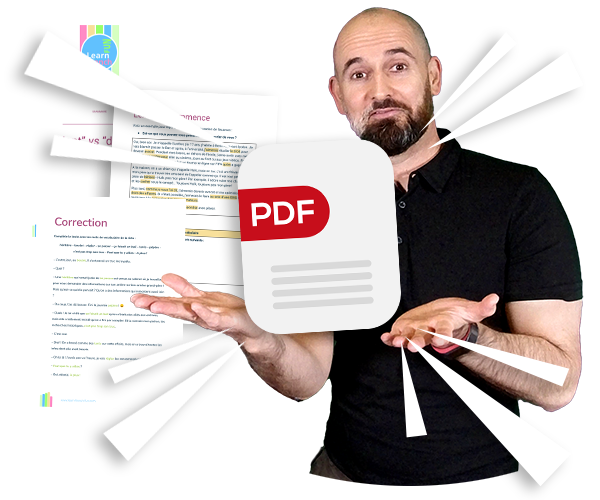If you are a student of French, you have undoubtedly encountered the direct object complement (C.O.D.). This little-known part of French grammar can be confusing at first, but with a little practice, you’ll be able to use it like a pro!
In this blog post, we’ll take a closer look at the C.O.D in French, and we’ll also learn about the direct complement pronouns. So pour yourself a cup of coffee and let’s get started!
Knowing how to use French direct pronouns correctly will be a very good thing to get a good score in the DELF B2 if you want to take the exam one day.
Today we will see French direct pronouns, but first, let’s remind ourselves about pronouns.

PDF Bonus
We have prepared a free PDF to help you understand and master the COD and direct pronouns in French.
👉 Download it for free
At the end, you will have exercises to practice with the correction. 👍
A pronoun in French. What is it?
A French pronoun is a word that replaces a noun, a word that is used in place of a noun. Thanks to the pronoun there is no need to repeat.
You already know the subject pronouns: “I”, “you”, “he”, “we”, etc. When you use them, you replace a noun.
You don’t have to say: the students are working, the students are nice; we say: “Students work, they are nice”.
OK, that’s all right. This is the subject pronouns, what is a pronoun?
Great. You can see also our article on tonic pronouns in French, or how to use “en” and “y” pronoun in French.
We want to see the French pronouns direct complements.
Do you like learning French with videos?
Receive our free video newsletter every Friday in your e-mail box. You will get 3 “Tips & Tricks” on grammar, vocabulary, phonetics or French culture.
👉👉 Sign up now!
What is a French direct complement pronoun?
So let’s see.
I see you, I don’t see you.
Let’s analyze this sentence: “Je vous vois pas” (I don’t see you)
First, it’s not very French, but for the example, it’s nice.
First thing in a sentence, we look for the verb.
→ What is the verb here? It’s the verb voir (to see): vois.
→ What is the subject? The second thing we are still looking for! “Je”. Je vois.
Here, in this sentence, it is in the negative form. That’s why there’s the “pas“. That’s an important thing.
A lot of French, orally, do not use the “ne” in the negation, but they use only the “pas“. This is not correct, the correct form “Je ne vous vois pas”, but very often the “ne” hop! And we say: “Je vous vois pas”. And strangely, the students do the opposite. They will say: “Je ne vous vois“, but they … “pas” to the trash.
No, no, no, no, no. You must always use the “pas”. Or the plus (no more), or the rien (nothing), or personne (nobody), or jamais (never), that still in the sentence! What you can remove, it is not recommended for a good French language, really correct, it’s the “ne“. But when speaking, it’s true, It’s something that’s common.
→ And the last part in this sentence, the: vous?
What is the vous? Je vous vois pas.
We have already seen that the subject is: Je. And the vous? It’s true that it looks very much like a subject pronoun – do you remember the list: “je, tu, il, nous, vous…” – but here, is it a subject pronoun? No, it’s already Je, the subject pronoun.
And a sentence or rather, a verb in the sentence, has never 2 subjects!
One verb, one subject, and that’s it.
So, what’s the vous? Of course, we’re doing a blog post on direct complement pronouns, so, it’s a direct complement pronoun!
Of course, this is easy. 😉
But how do you know it’s a direct complement pronoun? How do I know that?
The direct object complement in French
First of all, the direct complement pronoun replaces the COD, i.e. the Direct Object Complement of the sentence. This notion of COD is very important, because you will find it very often in many grammar rules. So it’s really important to understand what it is.
The COD:
- “C”: complement,
- “O”: object,
- “D”: direct;
direct object complement.
What is the COD?
- The subject… He does the action.
- The COD, he is the object of the action.
And how do we find the COD in the sentence? Simply with the question “who?” or “what?”
Method to find the COD in a French sentence
You have a very simple technique to find the COD: You take the subject of the sentence, because you obviously have looked for the subject and looked for the verb, always the first thing to do.
→ You take the subject, the verb and ask the question “who?” or “what?”
Well, the answer to this question is the COD.
Be careful, there must be no preposition. You know, “to”, “with”, “at”…
No! It must be a group of words a direct, simple word, without preposition.
An article is possible, but no preposition. Because otherwise it’s not a COD.
I’ll give you an example. A very simple example: “I eat the apple.”
- The verb: “to eat”,
- the subject: “I”
- The technique: “I eat what?” → The apple
“the apple” is the COD. It is the object of the action “to eat”.
You see, no preposition. It’s not: “I eat from the apple”, “I eat at the apple”,
“I eat at…” No! Only: the apple.
What do I eat? The apple? I know that “the apple” is the COD.
Now that I know it’s the COD, if I want to replace it with the pronoun direct complement, well, I’ll take the pronoun from the list of direct complement pronouns. And just replace it.
📌 Another thing, I’m going to change the position. Don’t worry, we’ll see about that.
Let’s look at the list of direct complement pronouns. As with the tonic pronouns, we will make a table, because you already know the subject pronouns and so we’re going to do correspondence with French direct complements.
| subject pronoun | direct complement pronouns |
| je | me |
| tu | te |
| il | le (l’) |
| elle | la (l’) |
| nous | nous |
| vous | vous |
| ils | les |
| elles | les |
We take the example again: Je mange la pomme.
La pomme (the apple) is not “I”?! it’s not “you”! It’s “elle” (in French, it’s “her”).
Look at the table of correspondence between the subject pronouns and the COD pronouns.
What is the COD pronoun? → la.
Position of the French COD pronoun in the sentence
I change the position. Where do I put the pronoun?
It’s very easy, always just before the verb. Always!
→ Je la mange (I eat it.)
Always before the verb. Always! Even in compound tenses. Even with negation, even with modal verbs. Always before, we’ll see examples.
And if you want, we have written an article that explains exactly the position of pronouns and negation words in French.
| 📌 Do you want to practice? Download the Little PDF Bonus. You will find some exercises to practice with the pronoun table, with several verbs, several tenses; like this, you’ll be able to practice. That’s what’s important… Practice! Download for free the Bonus PDF on COD & direct complement pronoun |
So be careful, the pronouns that can cause you problems:
- “il” → le ;
- “elle” → “la” ;
- “ils”, “elles” → “les”.
So, let’s take an example with each pronoun in the list.
- Je me regarde dans le miroir. (I look at myself in the mirror).
- Je le regarde. (I look at him).
- Je nous regarde. (I’m looking at us).
- Je les regarde. (I’m looking at them).
Imagine, with the last example: “I look at them”. Here we have the direct pronoun. But, don’t forget that a pronoun replaces a noun, the normal sentence could be:
- “I watch sportsmen”,
- “I watch actors”,
- “I watch women”,
but I replace with the pronoun: Je les regarde.
To summarize
So, to sum up, how do you do it?
First thing: Ask yourself, What do I want to replace? Is this a direct object complement? Is this an indirect object? How do you know that?
| 📌 A tip: When you write new vocabulary words, when you write a new verb, note if it is a verb you are using directly or indirectly, or both. For example: Téléphoner (To call): “Je téléphone quelqu’un ? or “Je téléphone à quelqu’un ?” (Am I calling someone?) Je téléphone à quelqu’un. TO someone, that means indirect verb! It means the list of pronouns that we have just seen, no, that doesn’t work. It’s other pronouns. So, when you write down a vocabulary verb, always remember to write down “direct“, “indirect” or both. For example, envoyer (to send), can be direct or indirect. This way, you will know which pronoun to use. And this is really important. |
So, finally, the question to ask yourself: Is it really a COD that I am replacing? OK, this is a COD. Use the pronoun that is correct that you have in the list!
✔️ French QUIZ
COD & Pronoms COD
Before leaving, let’s take this little quiz together to see if you understand 😀
Results
#1. Quelle est la phrase correcte qui peut remplacer : "On utilise le parasol à la plage".
#2. Quelle est la phrase correcte qui peut remplacer : "Le cuisinier coupe les légumes."
#3. Quelle est la phrase correcte qui peut remplacer : "J'écoute la radio tous les jours".
#4. Quelle est la phrase correcte qui peut remplacer : "Est-ce que tu aimes le fromage ?"
#5. Quelle est la phrase correcte qui peut remplacer : "Elle n'a pas regardé le film".
📌 Free PDF Bonus:
Do you want to do more exercises on COD and direct pronouns in French and have the correction? Have a summary sheet of the lesson?
Then download the free Bonus PDF!
So there you have it! The direct object complement in French. Now that you know all about it, go out and impress your friends by using this fancy grammar term correctly in a sentence.
And if you’re looking for more ways to learn French online, be sure to check out our other French grammar blog posts or sign up for one of our French online classes.
We can’t wait to help you become a fluent francophone! 👍
Articles that might interest you:
- The Imperative in French: How to Conjugate Verbs in Imperative? When do You Have to Use the Imperative?
- The 10 Irregular Verbs in the French Subjunctive Mood
- Depuis, pendant, en, il y a, dans
- All the secrets of the French gerund!
- French verb moods
- How to use the tonic pronouns in French?
- How to use “en” and “y” pronoun in French?
- Difference between DONT and DUQUEL in French
- 10 common French verbs conjugated in the present tense. Beware of traps!
- The Direct Object Complement in French (C.O.D.) and direct complement pronouns (le, la, les…)







5 thoughts on “The Direct Object Complement in French (C.O.D.) and direct complement pronouns (le, la, les…)”
Comments are closed.